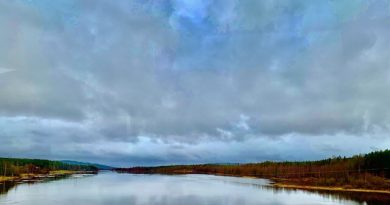Bering Sea ice remains extensive, sets another record
 Melt season has ramped up across the Arctic Ocean, with the polar pack losing an area almost the size of Alaska during the month of May, according to the latest analysis posted by the National Snow & Ice Data Center.
Melt season has ramped up across the Arctic Ocean, with the polar pack losing an area almost the size of Alaska during the month of May, according to the latest analysis posted by the National Snow & Ice Data Center.
“After reaching near-average levels in late April, sea ice extent declined rapidly during the early part of May,” the NSIDC said here. “The rest of the month saw a slower rate of decline.”
Overall, the May ice extent averaged about 5.07 million square miles — an area, strangely enough, just a little smaller than the ice-covered portion of Antarctica. That’s about 185,000 square miles below the long-term average, but still about 212,000 square miles above the record low for the month set in 2004.
Kind of sounds like nothing remarkable happened, even for a time of year that rarely introduces much drama into the decades-long sea ice decline saga. A Goldilocks month in the annals of ice.
But Alaska’s Bering Sea didn’t get the memo.
There was more ice in the Bering Sea last month than during any other May observed over the past 32 years of satellite monitoring. The stubborn floes raised havoc with fisheries and may possibly force end up forcing Shell Oil Co. to delay the first exploratory drilling in the Arctic in 20 years.
“Shell is saying that sea ice coverage in the Bering Sea is 30 to 40 percent above normal, the worst it’s been in 12 years,” KTUU reported here.
Tracking the extent and volume of sea ice is one of the most important windows on the Arctic’s changing climate, with most attention paid to the annual minimum that occurs in September or October. The polar ice cap plays an essential role in stabilizing the world’s climate, but has been shrinking to record and near record levels during the summers for the past decade. This loss speeds up global warming and thinning of existing ice because darker open water absorbs more solar energy than reflective white floes.
Strong populations of polar bears, walruses and seals also need sea ice for hunting and denning habitat, and its summer shrink could threaten their survival. Later ice return in fall exposes Alaskan villages to catastrophic storms and erosion.
Springtime is often the least eventful for sea ice monitoring, showing the smallest variation of any season. Still, in a normal May, the Bering Sea often goes ice free before the end of the month, shifting the communities along Alaska’s still-snowy west coast into summer subsistence mode and setting the stage for open water fisheries.
But this May ended with ice covering about 135,000 square miles of ocean off Alaska — an area almost the size of Montana.
The persistent ice cover in the Bering may be responsible for making the Arctic’s 2011-2012 ice season the most extensive in a decade, partly cancelling out the extremely low ice cover seen in the Barents and Kara seas.
What gives? It’s simple, really, and so familiar to Alaskans still cranky from one of the snowiest and coldest winters in recent memory.
“The higher than normal extent and late spring break up of the ice cover in the Bering Sea are mainly due to unusually low air temperatures and persistent winds from the north, related to a region of low atmospheric pressure centered over Kodiak, Alaska,” the NSIDC explained here. “As these cold winds slowed ice melt, they also pushed the ice edge to the south.”
Still, spring has begun to break the grip. “The ice has nevertheless started to break up and large areas of open water are now present in the northern part of the Bering Sea,” the NSIDC said.
In one curious development, sea ice has also begun to peel back from the Alaskan and Canadian coasts along the Beaufort Sea, largely due to winds breaking the connection between the floating ice pack and the shore fast ice. The action managed to open a vast reach northeast of Alaska, visible in this satellite image.
“That the open water areas have not refrozen points to the relatively warm conditions over the Arctic, particularly in the Beaufort Sea,” the NSIDC said.
And that’s not good news for the summer outlook.
“The ice cover in the southern Beaufort Sea is also substantially broken up, with many individual ice floes instead of a consolidated pack,” the NSIDC said in its discussion. “This makes the ice in this region vulnerable to enhanced melt during summer, as the sun rises higher in the sky and the dark open water areas between the floes readily absorb solar energy.”
Contact Doug O’Harra at doug(at)alaskadispatch.com
For more stories from Alaska Dispatch, click here



